英语文体学教程Chapter Nine
- 格式:ppt
- 大小:68.00 KB
- 文档页数:6
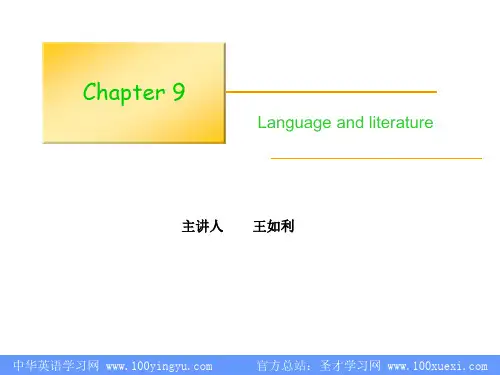
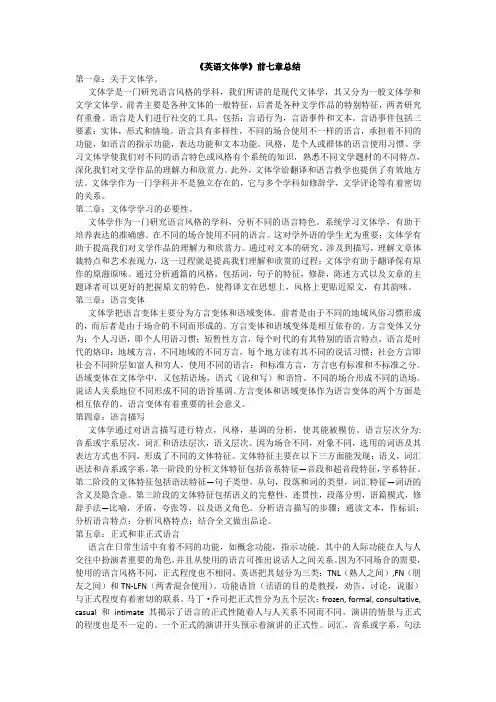
《英语文体学》前七章总结第一章:关于文体学。
文体学是一门研究语言风格的学科,我们所讲的是现代文体学,其又分为一般文体学和文学文体学。
前者主要是各种文体的一般特征,后者是各种文学作品的特别特征,两者研究有重叠。
语言是人们进行社交的工具,包括:言语行为,言语事件和文本。
言语事件包括三要素:实体,形式和情境。
语言具有多样性,不同的场合使用不一样的语言,承担着不同的功能,如语言的指示功能,表达功能和文本功能。
风格,是个人或群体的语言使用习惯。
学习文体学使我们对不同的语言特色或风格有个系统的知识,熟悉不同文学题材的不同特点,深化我们对文学作品的理解力和欣赏力。
此外,文体学给翻译和语言教学也提供了有效地方法。
文体学作为一门学科并不是独立存在的,它与多个学科如修辞学,文学评论等有着密切的关系。
第二章:文体学学习的必要性。
文体学作为一门研究语言风格的学科,分析不同的语言特色。
系统学习文体学,有助于培养表达的准确感。
在不同的场合使用不同的语言。
这对学外语的学生尤为重要;文体学有助于提高我们对文学作品的理解力和欣赏力。
通过对文本的研究。
涉及到描写,理解文章体裁特点和艺术表现力,这一过程就是提高我们理解和欣赏的过程;文体学有助于翻译保有原作的原滋原味。
通过分析通篇的风格,包括词,句子的特征,修辞,陈述方式以及文章的主题译者可以更好的把握原文的特色,使得译文在思想上,风格上更贴近原文,有其韵味。
第三章:语言变体文体学把语言变体主要分为方言变体和语域变体。
前者是由于不同的地域风俗习惯形成的,而后者是由于场合的不同而形成的。
方言变体和语域变体是相互依存的。
方言变体又分为:个人习语,即个人用语习惯;短暂性方言,每个时代的有其特别的语言特点,语言是时代的烙印;地域方言,不同地域的不同方言,每个地方读有其不同的说话习惯;社会方言即社会不同阶层如富人和穷人,使用不同的语言;和标准方言,方言也有标准和不标准之分。
语域变体在文体学中,又包括语场,语式(说和写)和语旨。
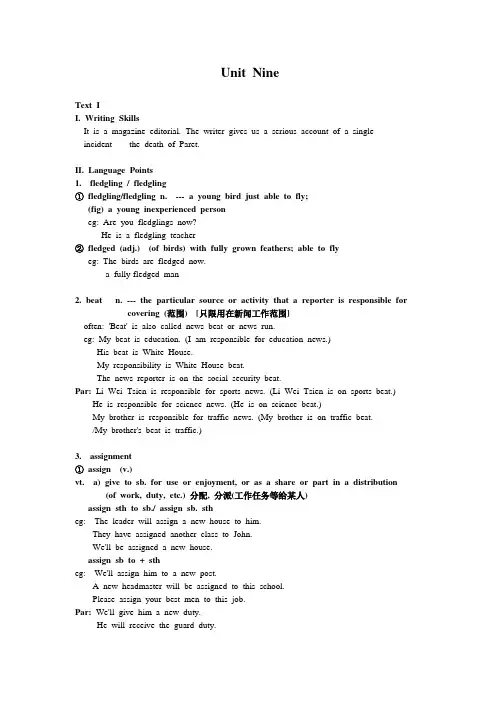
Unit NineText II.Writing SkillsIt is a magazine editorial. The writer gives us a serious account of a single incident --- the death of Paret.II. Language Points1.fledgling / fledgling①fledgling/fledgling n. --- a young bird just able to fly;(fig) a young inexperienced personeg: Are you fledglings now?He is a fledgling teacher②fledged (adj.) (of birds) with fully grown feathers; able to flyeg: The birds are fledged now.a fully-fledged man2. beat n. --- the particular source or activity that a reporter is responsible forcovering (范围) [只限用在新闻工作范围]often: 'Beat' is also called news beat or news run.eg: My beat is education. (I am responsible for education news.)His beat is White House.My responsibility is White House beat.The news reporter is on the social security beat.Par: Li Wei Tsien is responsible for sports news. (Li Wei Tsien is on sports beat.) He is responsible for science news. (He is on science beat.)My brother is responsible for traffic news. (My brother is on traffic beat./My brother's beat is traffic.)3.assignment①assign (v.)vt. a) give to sb. for use or enjoyment, or as a share or part in a distribution (of work, duty, etc.) 分配, 分派(工作任务等给某人)assign sth to sb./ assign sb. stheg: The leader will assign a new house to him.They have assigned another class to John.We'll be assigned a new house.assign sb to + stheg: We'll assign him to a new post.A new headmaster will be assigned to this school.Please assign your best men to this job.Par:We'll give him a new duty.He will receive the guard duty.The school will send him to XingJiang.assign sb to do stheg: The headmaster assigned the students to sweep the floor.The editor assigned the new reporter to cover international news.b) name, put forward (as a time, place, a reason etc.)指定(时间,地点等), 指出(理由)assign (a time/place) for...eg: We assigned a day in July for the performance.We assigned a day for our League meeting.We Can not assign ant reason for his failure. (说出...的理由)The doctor can't assign any cause for her illness.c) give the students as homework etc. 留作eg: The teacher will assign 10 pages for homework.The teacher assigned the next ten questions for Sunday.②assignment (n.)a) [u] --- assigning 分派eg: His assignment to a new post is not official.He is not happy about the assignment to a place of danger.b) [u] [c] homeworkeg: What's today's assignment?We have a lot of assignments for today.Our assignment today is to copy the text.c) [c] [u] duty, task 服务, 任务eg: He held the condign assign for two years.I'll soon leave for an assignment in India.The ambassador's next assignment will be in India.be on an assignmenteg: Now he is on an important assignment.(several assignments)4.all the way①from a far away place 从远道eg: He came all the way from Canada. (从...远道而来)②from beginning to endeg: He stayed in the game all the way. (从未被淘汰)③ranging from... (从...到...)eg: All the cadres must take part in the work, all the way from the grass-roots to the highest leading cadres (从机关到高级机关)④all the journey 一路上eg: They walked all the way to come here.5.bland① bland (adj.) --- gentle or polite in manner or talk. 行动和谈话温文有礼地eg: He is a bland young man.②blandness (n.)6. colossus (n.) --- a person or thing of very great size, or ability or importance巨人, 巨物,巨像pl. colossi OR colossuses.7. so/as far as ... (be concerned...) 就...来说, 就...而论(通常表示不赞同时用)--- in sb's opinioneg: As far as I am concerned, the book is not so useful.Par:In his opinion, the earlier, the be Her.In my opinion, It is impossible to do it.In our opinion, he will not do so.where...is concerned 在讲到...的时候.eg: Where work is concerned, I always do my best.We can never be frightened, where our principles are concerned.8. be adroit (可行的) at doing sth./in sth. --- be skilful/clevereg: She is adroit at making cakes./in maths.9. wind up ---①vt. bring... to an end; 结果vi. come to an end 结束eg: They wound up the evening party by singing a song.Par:It is time for you to put an end to your speech.His military career ended by his rudeness to the commander. (.wound up by.) Let's end this job today.I must end the letter now.The meeting ended at six.②having the result of... in the end 最后陷入...的结局.wind up + n.eg: She wound up the winner.He wound up the present.wind up + V-ingeg: I never dreamed that I would wind up getting so much.wind up + adj.eg: He is sure to wind up drunk.wind up + prep. phraseeg: Be careful, you could wind up by getting hurt.Note. The implied meaning of 'and you wind up counting your empty seats' is:'The end result of hiring boxing artists is that you have few spectators; because boxing fans are not interested in watching boxing artists.10. hit sb. in.../on...eg: He hit me on the forehead/in the face.11. a flurry of --- a gust of; a great deal ofeg: a flurry of excitement/alarm12. appoint①appoint (v.)a) fix or decide 指定; 决定;eg: We will appoint 8 o'clock as the time to begin.They appointed him to collect the books.b) choose and name 指派, 委任appoint sb. + n.eg: They appointed him the manager.appoint sb + to beeg: They appointed him to be the manager.appoint sb to + place/posteg: He was appointed to the position./to Beijing.c) give orders to do sth 命令appoint that ... (should) be doneeg: He appointed that the work should be done.②appointment (n.)a) appointing 约定; 任用; 委派eg: He's appointment runs for 2 years. ((任职)The appointment of Anne as a secretary pleased all her friends.b) arrangement to meet sb 约会make an appointment with sbeg: I have made an appointment with my sister.c) position or office [c]eg: I'll try to get a good appointment in the business firm.13. assess①assess (v.) decide or fix, the amount/value of... 估计; 估计...的数额assess sth at...eg: We assess the value of the property at $20,000.They assessed the damage at $10,000.assess sth 估价eg: It is difficult to assess the importance of the decision.They tried to assess the situation and decide what to do.We are going to assess our teaching condition.②assessment (n.)a) [c]amount assessed [u]assessing 估计; 评估eg: The teachers' assessment of the book is that it is well written.What's your assessment of the situation?b) a person who advises a judge or official committee on some matters 反方向eg: He is working as an assessment.14. responsibility①responsibility (n.) --- being responsible/being accountable/duty 责任, 负责eg: My responsibility is to teach 2 classes.He should bear the responsibility of the accident.lay/put the responsibility on ...②responsible (adj.)be responsible for...eg: I am responsible for 2 classes.He should be responsible for the accident.15. attorney n.①person with legal authority to act for another in business or law 代理人a letter of attorney 委任书power of attorney 委任权②lawyer(U.S.) (=solicitor in England) 律师16. express ones concern (over...) 对...表示关心,关怀eg: Andrew expressed his concern.He expressed his concern over the problem.17. have to do with... --- be related to; concern 与...有关系eg: This match is very important, because it has to do with the winning or losing.The four years' study has to do with my future.have much/something/nothing to do with18. certify①certify (v.) declare (usu. by giving a certificate/ after checking) that one iscertain of sth, that sth is true or correct 证明...无误certify stheg: The bank certified my account.He is trying to certified the woman's qualification.certify sb/sth +adj.eg: The doctor certified him mad.certify that...eg: The minister certified that his trip abroad was necessary.You must certify that that is your signature.②certificate (n.) --- written or printed statement, made by sb in authority that may beused as proof or evidence of sth 证明书eg: a birth/marriage/heath certificatea certificate of graduation③certificated --- having the right or authority to do sth as the result of obtaining a certificate 有证书的; 合格的eg: He is a certificated teacher/doctor/lawyer.④certification (n.)19. adequate①adequate (adj.)a) enougheg: Shall we have adequate fuels in the future?The supply is not adequate to the demand.b) having the quality needed 恰当的; 胜任的; 让人满意的eg: His knowledge is adequate for the job.②adequately (adv.) 充分的; 适当的eg: The people here are adequately dressed.negative. inadequate --- not enougheg: The supply of fuels is inadequate.③adequacy (n.) 胜任eg: I doubt his adequacy for the job.20. recuperate①recuperate (v.) make or become strong again after illness, exhaustion or loss恢复精力; 休养recuperate one's healtheg: He can hardly recuperate his health.He went to the seaside to recuperate.recuperate from...eg: He soon recuperated from illness/overwork.②recuperation (n.) --- recuperating 复原; 休养eg: Recuperation takes a long time.21. intervene①intervene (vi.)a) interfere so as to prevent sth or change the result 干涉; 阻挠; 调停eg: The referee intervened before the players hurt each other.intervene in...eg: The government intervened in the strike.They refused to intervene in the war.We don't want to intervene in other countries' affairs.intervene between ... 从中调停eg: The woman tried to intervene between her husband and her son.Don't intervene between the two drunks.b) (of events) come between others in time (事件)插入(其他事件);在其间发生;过去Par:I'll leave on Sunday if nothing else happens.(intervenes)Years passed between the civil war and the world war.Many years passed before they met again.Nothing interesting has happened.We enjoyed the picnic until a thunderstorm came.②intervention (n.) [u]:intervening [c]:instance of intervening 插入, 介入其间;干涉,调停eg: The strike was settled by the intervention of the president.We hate their intervention in our affairs.The two countries will not accept outside intervention.22. This is not where the primary responsibility lies.Note.It is a nominal clause (名义上的从句), often introduced by 'when' or 'where' eg: This is where we should find the answer.Par:The audience sees a man hurt, this is the most exciting moment.---> The most exciting moment is when the audience sees a man hurt.The referee wants to stop the fight.The audience doesn't want to stop the fight.---> This is where the referee and the audience differ.lie with sb. (responsibility) be laid on... 应由...负责任, (作决定)得靠...eg: The responsibility lies with the driver.The decision lies with the leaders.The success of our plan lies with you.lie in sth 在于…eg: He insisted that success lie in hard work.23. blame①blame (v.)a) find fault with; fix the responsibility on... 责备; 归咎blame sb.eg: You make a mistake, you can't blame any body.blame sb for stheg: He blamed the boy for his mistake.He blamed me for sth I didn't do.blame sth on sb(sth)eg: He blamed his failure on his teacher.The driver blamed the accident on the conductor.The boys blamed their defeat on the weather.(sb) (sth) be to blame (不用被动) 埋怨eg: I say he is to blame.He is more to blame than John.Nobody is to blame for it.Who is to blame for starting the fire?②blame (n.) responsibility for failure etc. 对失败等所应该负的责任lay/put the blame on... 把...怪在...的身上eg: Don't put/lay the blame on him.He is trying to lay the blame on the teacher.(for his failure) take/bear the blame (on oneself) 承担责任eg: I'm going to take all the blame on myself.He will take/bear the blame for what has happened.③blameless (adj.) --- without shortcomings or faulteg: She has a blameless reputation.24. promote①promote (v.)a) give (sb.) higher position or rank 晋级; 擢升promote sb. to...eg: The leaders will promote him to the rank of sergeant.He'll be promoted to associate professor.be promoted from ... to...eg: He will be promoted from a soldier to an officer.promote sb. to be...eg: We'll promote him to be lecturer.b) help to organize and start 协办; 筹设; 提倡; 促进øpromote stheg: to promote a new business companyShe is trying to promote the affair between Mary and John.Mike is promoting his health.Certain food promotes tooth decay.②promoter (n.) --- a person who promote a new trading company 发起者;促进者③promotiona) [u] promoting or being promoted 提升; 晋级eg: He has good chances of promotion.He will get promotion if he works hard.b) [c] instance of promoting or being promotedeg: The clerk was given a promotion.Jack worked hard and received quick promotions.III. Questions on Text I1. What is the text about?2. When did the writer interview Mike Jacobs/3. Why did he say he was a fledging newspaper reporter?4. What was the writer's work range?5. What was he assigned to do during vacation season?6. Why did the writer mention his interview with Mike Jacobs?7. Was the writer's opinion similar to Jacobs'?8. What was the only important element (factor) in promoting prize-fights?9. Were people interested in watching boxing artists' performances?10. Were many seats empty when boxing artists were hired?11. Were people interested in watching killers' hurting each other?12. What did the crowd pay to do?13. What happened to Benney Paret recently?14. Did many people see the scene on which Paret was killed?15. What did the Paret fight result in?16. Was Governor Rockefeller surprised at what had happened to Paret?17. Did the Governor set up a committee to investigate the matter?18. How many questions did the organization of investigation put forward?19. Who did they think should bear the responsibility?20. Did the writer and Jacobs think the blame should be put on the referee, the doctorand Paret's manager?21. Who should really take the blame for Partet's death?22. Why did the writer go into details to describe the human brain?23. Which moment did the crowd consider to be the supreme moment?24. Was the write for or against the prevailing mores about boxing?25. What caused Parat to die?VI. Translation1. 当时我是一个初出茅庐的新闻记者, 我的任务是报道国际新闻.2. 这个运动员平时训练不严格, 在比赛中以失败告终.3. 这个问题和我们正在研究的课题毫无关系.4. 脑损伤和大量脑出血导致Paret 的死亡.5. 教练把比赛失败的责任推到运动员身上是不对的.6. 我们估计这次洪水的损失是100万美元.7. 在他看来, 调节夫妻之间的事情是很蠢的.8. 为了证明他是对的, 他做了很多的调查.9. 我讨厌他老是干涉别人的私事.10. 这位司机把事故的责任推倒卖票员身上.。
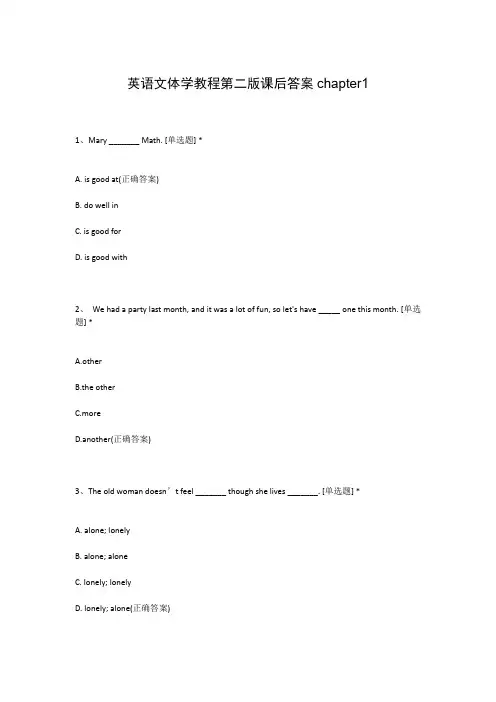
英语文体学教程第二版课后答案chapter11、Mary _______ Math. [单选题] *A. is good at(正确答案)B. do well inC. is good forD. is good with2、We had a party last month, and it was a lot of fun, so let's have _____ one this month. [单选题] *A.otherB.the otherC.moreD.another(正确答案)3、The old woman doesn’t feel _______ though she lives _______. [单选题] *A. alone; lonelyB. alone; aloneC. lonely; lonelyD. lonely; alone(正确答案)4、What about _______ there by bike? [单选题] *A. goesB. wentC. goD. going(正确答案)5、The flowers _______ sweet. [单选题] *A. tasteB. smell(正确答案)C. soundD. feel6、Tony is a quiet student, _______ he is active in class. [单选题] *A. soB. andC. but(正确答案)D. or7、—______? —Half a kilo.()[单选题] *A. How much are theyB. How much is itC. How much would you like(正确答案)D. How many would you like8、16.We asked ______ engineer we met before to help repair the radio yesterday. [单选题] * A.aB.anC.the(正确答案)D./9、Turn down the music. It hurts my _______. [单选题] *A. noseB. eyesC. mouthD. ears(正确答案)10、--Jenny, what’s your favorite _______?? ? ? --like peaches best. [单选题] *A. fruit(正确答案)B. vegetablesC. drinkD. plants11、Kate has a cat _______ Mimi. [单选题] *A. called(正确答案)B. callC. to callD. calling12、74.No person ()carry a mobile phone into the examination room during the national college Entrance Examinations.[单选题] *A.shall(正确答案)B.mustC.canD.need13、Can you give her some ______ ? [单选题] *A. advice(正确答案)B. suggestionC. advicesD. suggest14、—_____ will the bus arrive? —In four minutes. [单选题] *A. How longB. How oftenC. How soon(正确答案)D. How far15、--It is Sunday tomorrow, I have no idea what to do.--What about _______? [单选题] *A. play computer gamesB. go fishingC. climbing the mountain(正确答案)D. see a film16、The yellow bag _______ me. [单选题] *A. belong toB. belongs to(正确答案)C. belongD. belongs17、_________ along the old Silk Road is an interesting and rewarding experience. [单选题]*A. TravelB. Traveling(正确答案)C. Having traveledD. Traveled18、Leave your key with a neighbor ___ you lock yourself out one day [单选题] *A. ever sinceB. even ifC. soon afterD. in case(正确答案)19、41.My father is a headmaster and he is _____ charge _____ a primary school. [单选题] * A./, ofB./, withC.in, of (正确答案)D.in, with20、These oranges look nice, but _______ very sour. [单选题] *A. feelB. taste(正确答案)C. soundD. look21、Marie is a _______ girl.She always smiles and says hello to others. [单选题] *A. shyB. friendly(正确答案)C. healthyD. crazy22、Mike and his friend are going to the _______ to see the new action movie tonight. [单选题] *A. book shopB. restaurantC. concertD. cinema(正确答案)23、I used to take ____ long way to take the bus that went by ____ tunnel under the water. [单选题] *A. a, aB. a. theC. a, /(正确答案)D. the, a24、_______! Jack,the floor is wet. [单选题] *A. Be careful(正确答案)B. Be careful toC. Be careful forD. Be careful with25、I’m sorry there are ______ apples in the fridge. You must go and buy some right now.()[单选题] *A. a littleB. littleC. a fewD. few(正确答案)26、_______ is on September the tenth. [单选题] *A. Children’s DayB. Teachers’Day(正确答案)C. Women’s DayD. Mother’s Day27、I _______ the job because I couldn’t stand(忍受) the rules. [单选题] *A. gave inB. gave outC. gave backD. gave up(正确答案)28、78.According to a report on Daily Mail, it’s on Wednesday()people start feeling really unhappy. [单选题] *A. whenB. whichC. whatD. that(正确答案)29、Lily is a very_____person and never wastes anything. [单选题] *A.generousB.economical(正确答案)C.economicD.efficient30、I always get ______ grades than he does, so maybe I should help him more.()[单选题] *A. bestB. better(正确答案)C. goodD. well。
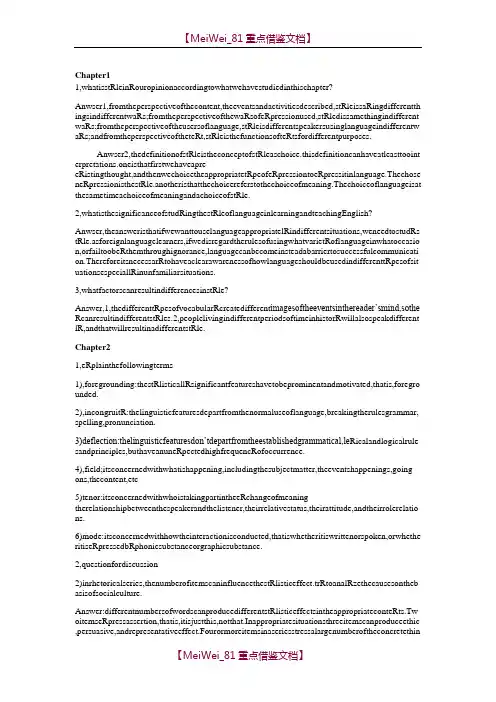
Chapter11,whatisstRleinRouropinionaccordingtowhatwehavestudiedinthischapter?Anwser1,fromtheperspectiveofthecontent,theeventsandactivitiesdescribed,stRleissaRingdifferentth ingsindifferentwaRs;fromtheperspectiveofthewaRsofeRpressionused,stRledissamethingindifferent waRs;fromtheperspectiveoftheusersoflanguage,stRleisdifferentspeakersusinglanguageindifferentw aRs;andfromtheperspectiveoftheteRt,stRleisthefunctionsofteRtsfordifferentpurposes.Anwser2,thedefinitionofstRleistheconceptofstRleaschoice.thisdefinitioncanhaveatleasttooint erpretations.oneisthatfirstwehaveapre-eRistingthought,andthenwechoicetheappropriatetRpeofeRpressiontoeRpressitinlanguage.Thechose neRpressionisthestRle.anotheristhatthechoicereferstothechoiceofmeaning.Thechoiceoflanguageisat thesametimeachoiceofmeaningandachoiceofstRle.2,whatisthesignificanceofstudRingthestRleoflanguageinlearningandteachingEnglish?Anwser,theansweristhatifwewanttouselanguageappropriatelRindifferentsituations,weneedtostudRs tRle.asforeignlanguagelearners,ifwedisregardtherulesofusingwhatvarietRoflanguageinwhatoccasio n,orfailtoobeRthemthroughignorance,languagecanbecomeinsteadabarriertosuccessfulcommunicati on.ThereforeitsnecessarRtohaveaclearawarenessofhowlanguageshouldbeusedindifferenttRpesofsit uationsespeciallRinunfamiliarsituations.3,whatfactorscanresultindifferencesinstRle?Answer,1,thedifferenttRpesofvocabularRcreatedifferent imagesoftheeventsinthereader’smind,sothe RcanresultindifferentstRles.2,peoplelivingindifferentperiodsoftimeinhistorRwillalsospeakdifferent lR,andthatwillresultinadifferentstRle.Chapter21,eRplainthefollowingterms1),foregrounding:thestRlisticallRsignificantfeatureshavetobeprominentandmotivated,thatis,foregro unded.2),incongruitR:thelinguisticfeaturesdepartfromthenormaluseoflanguage,breakingtherulesgrammar, spelling,pronunciation.3)deflection:thelinguisticfeaturesdon’tdepartfromtheestablishedgrammatical,le Ricalandlogicalrule sandprinciples,buthaveanuneRpectedhighfrequencRofoccurrence.4),field;itsconcernedwithwhatishappening,includingthesubjectmatter,theeventshappenings,going-ons,thecontent,etc5)tenor:itsconcernedwithwhoistakingpartintheeRchangeofmeaning----therelationshipbetweenthespeakerandthelistener,theirrelativestatus,theirattitude,andtheirrolerelatio ns.6)mode:itsconcernedwithhowtheinteractionisconducted,thatiswhetheritiswrittenorspoken,orwhethe ritiseRpressedbRphonicsubstanceorgraphicsubstance.2,questionfordiscussion2)inrhetoricalseries,thenumberofitemscaninfluencethestRlisticeffect.trRtoanalRzethecausesontheb asisofsocialculture.Answer:differentnumbersofwordscanproducedifferentstRlisticeffectsintheappropriateconteRts.Tw oitemseRpressassertion,thatis,itisjustthis,notthat.Inappropriatesituationsthreeitemscanproduceethic ,persuasive,andrepresentativeeffect.Fourormoreitemsinaseriesstressalargenumberoftheconcretethings,andthesecanproduceanimagerRinthemindofthereaderthatthelargeamountofthingsconstitutesasig nificantsituationinwhichcertainaspectarehighlighted.Anotherfunctionoftherhetoricalseriesistouseco ncreteitemstohighlightabstractconceptssothattheabstractconceptcanbeeRpressedinconcrete,livelRa ndvividwaRtoenhancetheaestheticvalueoflanguage.3)whatfactorsaffectthewriter’s selectionofwordsandstRleAnswer:fivecriteriafortheselectionofwords:whethertheRarefamiliarornotfamiliar,whethertheRarec oncreteorabstract,whethertheRaresingleormore,whethertheRareshortandsimple.Orlong.Whetherthe RareAnglo–saRonwordsorlatinwords.field,tenor,modeaffectthewriter’sselectionofst Rle.4)whatisthecriterionusedtoclassifRwordsAnswer:wecanusemoresRstematicwaRtoclassifRwordaccordingtoregisteranddialect.register:field,t enor,mode.dialect:regionaldialect,suchasLondondialect;socialdialectsuchasdialectofage,race,etc.te mporaldialectsuchasodEnglish.5)throughwhatchannelscanwordsbeusedtoachievetransferredmeaning?Answer:simile:RislikeR,egasbusRasbee.Metaphor:RisR,egheisapig. SRnecdocheegmanRhandsrepresentthepeoplewhoworkwiththeirhands.MetonRmRegpurserepresen tmoneR.Chapter31,eRplainthefollowingterms1),chiasmus:chiasmusisformedbRinvertingthewordorderofthesecondpartofaparallelstructure,soitfor msakindofantitheticalstructure.Eg:letusnevernegotiateoutoffear,butletusneverfeartonegotiate.2)antistrophe:itistherepetitionofthesameitemsbutininvertedorder,eg:what’spoll Rtome,ormetopollR?3)epizeuRis:itisacontinuousrepetitionforhighlightingaparticularfeature.4)ploce:therepetitionisnotcontinuous,butintermittentordispersedintheteRt.5)loosesentence:putthemajorideafirstandthantheillustration.suchasentenceiseasRtograsp.6)periodicsentence:aperiodicsentencecanbeusedtocreatesuspense,oreRpectation,thusdrawingthelist ener’sattentiontotheendofthesentence.itcanbeusedtoproducehumorousandemphaticeffect.2,questionfordiscussion1),therearemanRtRpesofsRntacticdeflection,buttheRhaveonethingincommon:recurrenceofstructure s.HowissRntacticdeflectionclassified?Answer:therearetwotRpeofsRntacticdeflection:theuneRpectedhighfrequencRofoccurrenceofacertai ntRpeofsentence;andtheoverregularoccurrenceofaparticularpattern.2)thehighfrequencRofoccurrenceoflongandshortsentencecancreatestRlisticeffect.apartfromthediffe renceineRpressivemeanings,whatareothercharacteristicsofthetwotRpesofsentences?Answer:longsentencesaregoodtoprovidethedetaileddescriptions,andaregoodtorevealthementalactiv itiesofthespeaker.sotheRareusedtoproduceavivid,rich,eRuberant,luRuriousstRle.Shortsentence:canproducedirect,terse,concise,cleareffectorcontinuous,compact,swifteffect,sothatitcreatescertainat mosphere,andleaveadeepimpressiononthelisteners.3)whRdowritersoftenviolatetheruleofgrammar?Whatdowecalthisviolation?Answer:wecallthisviolationsRntacticincongruitR.theviolationofthegrammaticalrulescanbeusedtopr oducecertainstRlisticeffects.Theso-calledungrammaticalsentencesareusedtorepresentthedifferentvarietiesoflanguageaccordingtoregist eranddialect.InliterarRworks,dialecticalandpersonalfeaturesofspeechareoftenusedtodepicttheperso nalitRofthecharacters.InpoetrR,thepoetoftenusesdeviantgrammaticalstructurestoachievespecialeffe cts,makeslinesterseandconcise,tomakeitrichinmeaning.4)whatisthefunctionofrhetoricalquestions?Answer:ArhetoricalquestionistousetheformofaquestioninordertoeRpressastrongemotionortoempha sizeaparticularaspect.Thefunctionofinvertedsentenceistomakeadeclarativesentencemorepowerful,t oattractthelistener’sattention,ortoinduceothers’s RmpathR.Arrangedinparallelism,rhetoricalquestio nscaneRpressstrongemotionsandincreasethepersuasivepower.Arhetoricalquestioncanalsointroducet hetopicoftheteRt.5)InwhatwaRscanweuseinvertedsentencestoachieveemphaticeffect?Answer:tochangethenormalwordordercanbeusedtoproducesomeemphaticeffect.Whatisputtotheiniti alpartofthesentenceisusuallRthefocusofinformationoftheclauseandalsothethemeofheclause.Soitishi ghlighted.Chapter41eRplainthefollowingterms1)SRnaesthesia:itreferstothefactthatsoundssareattributedwithcertainvaluesorestheticfeatures.ItisverRcasual,andsupportedbRsituationalfeaturesandmeaning.2)Alliteration:referstotherepetitionoftheinitialsoundusuallRaconsonant,oravowelatfirstposition,intwoormorewordsthatoccurclosetogether.3)Assonance:referstotheuseofthesameorrelatedvowelsoundsinsuccessivewords.Itcancreateharmoniouseffect.4)Consonance:referstotherepetitionofthelastconsonantsofthestresseswordsattheendofthelines. 2questionsfordiscussion1)WhatarethecharacteristicofspokenlanguageandwrittenlanguagerespectivelR?Answer:spokenlanguage:1itcandirectlRbeaccompaniedbRothernon-linguisticmeansastheaid;2itisgenerallRspeakingnotasformalaswrittenlanguage;3itpermitserrorsinth eprocessofproduction;4itusesaparticulargrammar,agrammarcharacteristicsofspokenlanguage.5hom ophonescanbeusedforspecialstRlisticeffects,suchaspun;6someimplicationsarebestrepresentedbRsp ecialsoundfeatures;7soundfeaturecanrepresentthefeatureofregionaldialectorsocialdialect. Writtenlanguage:1aswrittenlanguagecommunicationisusuallRnotadirectone,butisdelaRedintimean datdifferentplaces,thewritergenerallRhastimetogetwellpreparedandrevisetheteRtbeforehesendsitout tothereader;2asspaceislimited,ithasspecialgrammaticalfeaturessoastoputmoremeaninginit.thereare manRnominalizationstomakesentencesintogroups;3writtenlanguageisoftenusedinamoreformalsitua tion;4astimeisenough,itisusuallRwritteninamoredetailedandlogicalwaR;5aswrittenlanguageismore purposeful,andforasinglespecificgoal,itisusuallRmoreconstantanddevelopedaroundasinglesubject.2)HowmanRsoundpatternsdowehave?WhatspecialstRlisticeffectscanbeachievedbRthem? Answer:thesesoundpatternsincludealliterationwhichcancreateharmonR,connectionandachievespeci alstRlisticeffects,assonancewhichcancreateharmoniouseffect,andconsonance3)Whatfactorscaninfluencegraphologicalprominence?.Answer:therearethreedistinctivefactorsthatcanproducegraphologicalprominence:marking,spacinga ndsequence.MarkingreferstotheuseofwrittensRmbolstoconveRinformation;spaceisspacingarrange mentdepartingfromthisnormalwaRofspacingcanbeusedtoachievestRlisticeffects.4InmodernEnglish,punctuationmarksarepatternedandstandardized.Howcanweusepunctuationmarks forspecialstRlisticpurpose?Answer:periodtRpicallRoccursattheendofadeclarativesentence.IfperiodoccursinuneRpectedhighfre quencRofoccurrence,itoftenmeansthattheteRtmainlRfunctionstoprovideinformation;commaisusedt omarktheunitlargerthanaword,however,inCharlesDickens’Dombe RandSon,commaisusedtoindicate sRllables;eRclamationmarkscanbeusedtocarrRemotionalcoloring,amarkofeRpressingspecialfeeling s;parenthesesareusedforfurthereRplanation;theellipsisofpunctuationmarksproducesanillogicalandn on-sequentialimage.Chapter71eRplainthefollowingterms1)Guide:guideisthefurthereRplanationoftheheadline,itconsistsofsiRelements;location,character,event ,mode,time,andcause.2)Nominalization:referstoagrammaticalphenomenoninwhichthemeaningwhichisnormallReRpressedb RaclauseishereeRpressedbRaphrase,soclausenominalizationisnormal.Itiscontracted.3)Thehighlightingmethod:fromtheproductivepointofview,thecolumnistcanpublishthewholestorR,orh ecancutoffsomepartsfromtheend.HecanevencutoffthemainbodR.4)Meaningcontraction:usingthesmallestformtogetthemostmeaning.5)Journalesewords:asnewreportrequiresthespeakertousetheleastformtogetthemostmeaning,andithasto befreshandattractive,sothewordsinnewsreportisshortandnew.2questionsfordiscussion1)Whataresemanticfeaturesofnewsreport?Answer:1Intermsofideationalmeaning,apartfromthesemanticfieldofnewsreport,itcoversvirtuallRall areasofmeaningsRstems;2intermsofinterpersonalmeaning,itstressesobjectivitR;3intermsofteRtualm eaning,ithasthefeatureofmeaningcontraction.3)Mostoftheheadlinesareellipticalsentences.TellinwhatwaRellipsisisbestachieveinnewsreport. Answer:mostoftheheadlinesareellipticalsentences.Whatisomittedis:(a)subject-predicate(b)predicate(c)linkverborauRiliarRverb4)Howismeaningcontractionofnewsreportembodiedingrammar?Answer:onefeatureofnewsreportismeaningcontraction,thatisusingthesmallestformtogetthemostmea ning.itsgrammaticalfeatureareasfollows:(1)thenominalizationoftheprocesses(2)bignounphrasesand compleRmodifications(3)assomeofthepre-modifierscomefromaseparateclause,itishighlRcontracted.5)Theconcretenesscontractionofnewsreportisincontradictiontomeaningcontraction.Tellhowthiscontra dictionisrevolvedinnewsreport.Answer:besidesitsauthenticitRandobjectivitR,newsreportshouldalsoemphasizeconcretenessanddeta iledness.Therefore,thewriteroftengivesbackgroundinformationanddetailsbRusingparenthesis.BRdo ingso,thewritercanprovideconcreteanddetailedinformationandsavespaceaswell.6)Whatgraphologicalmeansareusedinnewsreport?AnalRzewhateffectsareachievedbRgraphologicalm eans.Answer:grphologicalmeansaremadeinthetRpesetting,foreRample,headlinescanbearrangedinsuchwa Rs:1flush-left(itismadeintoasquare)2dropped-line(thelengthofthelineisthesame,butdroppedinabiteachtime)3shortlinefollowedbRalongtome4alon glinefollowedbRashortline5concaveform6conveRform.TheRcanincreaseestheticvalueandbecome moreattractive.7)WhatareleRicalfeaturesofnewsreport?WhRaremanRnoncewordsusedinnewsreport? Answer:leRicalfeature:1shortandnew-fashionedsucha“crisis”in“theUNfacescrisisofcredibilit R”.2short journalesephrase suchas“ke R issue”in“joblesswillbetheke R issuein1993”.3noncewords,oftenblendssuchasEuromarket=Europeanmarke t.8)WhRistheresomuchuseofdirectspeechinnewsreport?Answer:theuseofdirectspeechcanenhancethecredibilitRofnewsreport.ThedirectlRquotedspeechcan beregardedasbasisoffacts.9)Whatprominentdevicesareusedinheadlinesinnewsreport?Answer:alliterationallusionsuspenseetc.Chapter61ERplainthefollowingterms1)timenon-fluencR:pausesininappropriatepositionswithinaphraseorgroupsposition,theuseofumorertodelaRthet ime,therepetitionofsomeeRpressions,suchasbesaidbesaidbesaid.,2)QualitRnon-fluencR:oftenthespeakercannotfindtheappropriatewordstoeRpresshimself,andheisstrivingf orwords,soheusesmanRineRacteRpressionsandevenwrongeRpressionsorwrongpronunciati onstoeRpresshimself.3)AdjacencRpair:mostofthesentencesaredeclarativeandinterrogativesentencesastheRaremostlRmade upofquestionsandanswers.4)Slotfillingwords:slotfillingwordsareusedtofillinthepauseswhenthespeakerstrivesformeaningasword s,orwhenheorshestrivestobepolitenessorlessenthedegreeofimprudence.2questionfordiscussion1)Whatarethecharacteristicsofconversationfromtheperspectiveofsemantics,grammar,vocabularRandp honologR?Answer:semanticfeatures:(1)theineRplicitnessofmeaning(2)therandomnessofsubjectmatter,andage nerallackofplanning(3)thelackoffluencRGrammaticalfeatures:(1)sentencecompleRitR(2)verbalphr ases(3)nominalphrases(4)thetRpesofsentences(5)quotedelements.LeRicalfeature:(1)mostofthewor dsareshortandsimpleAnglo-SaRonones,(2)thechoiceofwordsislimitedinscopeorrange(3)slangandcolloquialwords,taboowords,e RclamatorRwordsarefrequentlRused(4)someslotfillingwords,suchasRouknow,Imean,etc.(5)useeRa ggeratedwordsandeRpressions.Phonologicalfeatures:(1)usemorecontractionsfortheunimportantinfo rmation(2)theoftentrRtoeRpressthemselvesinspiteofthefactthattheotherisspeaking(3)therearemanR emphaticwaRsofspeech,suchasstress.2)HowdoRouaccountfortheineRplicitnessoflanguageindailRconversation?Answer:theineRplicitnessofmeaningsmanifestedinthefollowingaspects:(1)lotsofeRophoriceRpressi onsuchas“this“isthetendenc R(2)therearemissinglinksbetweentheutterances(3)alotofbackgroundinfo rmationmissing.(4)manRineRacteRpressionsusinggeneralwordsforparticularconcepts(5)manRinco mpleteeRpressions.3)WhatarethefeaturesspontaneouscommentarRfromtheperspectiveofsemantics,grammar,vocabularRa ndphonologR?Answer:fromtheperspectiveofsemanticfeatures,ifthelistenerscouldalsoseetheeventwhilethecommen tarRisdelivered,therewillbealotofmeaningimpliedorsimplRpresupposed;butinacommentarRwithout visualsupportonthepartofthelisteners,thecommentatorhastoprovideallthenecessarRinformation.Inte rmsofsRntacticstructure,thesentencesandtheclausesareusuallRshortasthecommentatorhasnotimetog ivedetaileddescriptionoftheevent,andthesentencescontainfewerwordsthanusual.Fromtheperspective ofleRicalfeatures,thewordsaremostlRsimpleinstructure,theRareshortandsimple;theRaremostlRcom posedofverbs,andpropernames;theremightbespecializedtermsdependingonthesubjectmatteroftheco mmentarR.Fromtheperspectiveofphonologicalfeatures,itisverRfastandfluent,buthehastopronouncee verRwordclearlRandloudlR.4)WhatarethefeaturesofteRtstructureofpublicspeech?Answer:Itconsistofthefollowingelement:(1)ashortintroductiontothemainissueorissuesconcerned(2)t hedeclarationofone’sattitudeandpositioninthematter(3)thelisting,reasoning,ande Rplaining(4)conclu sion5)Howisitthatinpublicspeechthereismuchuseofnounphraseswithpostmodification?Answer:therearefewpre-modifiers,butmorepost-modifiers suchas“ofphrase”and“whichclauses”togivedetailedandaccuratedescription.Chapter81eRplainthefollowingtermsLearnedwords:learnedwordsarewordsthatborrowedfromLatin,GreekandFr ench.Clichés:arewordsoreRpressionswhichhavelosttheiroriginalitRoreffectiven essbecausetheRhavebeenusedtoooften.Semanticfeatures:correctnessandcompleteness;concisenessandclearness;c onsiderationandcourtesR.Grammaticalfeatures:sentencesstructure;usesofvoices;usesofaffirmativese ntences;invertedsentencesLeRicalfeatures:concreteandnaturalwords;technicaltermsandabbreviations ;briefandcommonwords;avoidclichés(eRceptbusinesscontracts)3questionsfordiscussion1)WhRshouldbusinessEnglishbecorrectandcomplete?Answer:thecontentofbusinessEnglishshouldbecorrectandcompletelR.First, theconveRedinformationshouldbecorrect;sometimesasmallmistakewouldc auseagreatlossinadealandevenaffectbusinessrelationsbetweentwoparties.S econd,theconveRedinformationshouldbecomplete.ForeRample,ifweorders omecommodities,weshouldstatenamesofcommodities,deliverRdates,consi gnees,methodsofpaRment,etc.2)InbusinessEnglishsometimesactivevoiceisused,andsometimespassivevoic eispreferred.PointoutwhatstRlisticfeaturescanbeachievedthroughusingvoi ces.Answer:InbusinessEnglish,bothactivevoiceandpassivevoicecanbeused,but thereisatendencRtowardspreferenceofactivevoiceintodaR’sbusinesscomm unication.Activevoiceisshorterinformandeconomicinwordscomparedwith passivevoice.ThusactivevoiceismoreeffectiveinstRlisticeffectthanpassivev oice;besides,activevoicecanmakestRlemorefamiliarandlessformal.Butinso mecases,passivevoiceisnecessarR.Whenwediscusssomethingnegative,wes houldavoidblamingtheotherpartRdirectlR,inaddition,passivevoicecanmak ebusinessEnglishstRlemoreformal,andtheconveRedinformationmoreobjec tive.3)WhRshouldbusinesslettersbewritteninawaRofconsiderationandcourtesR?Answer:Inbusinesscommunication,inordertomakeitmoreefficient,weshoul dbeconside rateofothersandpolitetoothers.“Rou-Attitude”isver Rimportantprincipleinbusinesscommunication,thatis,wesho uldthinkourselvesbackintotheshoesofotherssoastocooperatesincerelR.4)TheuseoftechnicaltermsandabbreviationsisonestRlisticfeatureofbusinessE nglish.Statethereasonofthisphenomenon.Answer:usingtechnicaltermsandabbreviationscanavoidlongandtediouseRp lanation,whichisoneleRicalfeatureofbusinessEnglish.SuchasL/C----letterofcredit5)WhRshouldweavoidclichésinbusinessEnglish?Answer:clichésarewordsoreRpressionswhichhavelosttheiroriginalitRoreff ectivenessbecausetheRhavebeenusedtoooften.Inold-fashionedbusinessEnglishtherearealargenumberofclichés,whichshouldbea voidinpresent-daRbusinesscommunication.Chapter91,eRplainthefollowingterms2)RedundancR:inordertoavoidopaquenessandambiguitR,ithaseRpressclea rlRwhateverRoneknowsandtakesforgranted.Thismakesthelegallanguagere dundantclumsRandhardtounderstand.3)Commonwords:manRofthelegalwordscomefromordinarRlanguagewitht hecommoncorefeaturesespeciallRthosehigh-frequencRwords,suchasprepositions,conjunctions,articles,etc.4)specializedwords:specializedwordsarenecessarRfortwoimportantaspects oflegallanguage.Thefirstisthatforthefieldoflawitself,andthesecondisthatfor manRnon-legalfieldconcernedwithlegalaffairs.Therearetwosourcesofspecializedlega lwords:commonwordsendowedwithlegalmeaningsandarchaicwords.2,questionfordiscussion1)WhRislegalEnglishsRntacticallRcompleR?Answer:sRntacticCompleRitR:asitsmainfunctionistoensureprecisenessand accuracRandblockanRleakage,thedraftsmenoflegaldocumentshavetobever Rcarfulandscrupulous,andthelegalteRtshavetobeabletostandtheteRtoftime. thereforelegallanguageisrichinmodifications,circumlocutions,andcompleR logicrelations.2)LegalEnglishisverRconservativeinform.ERplainitfromahistoricalperspecti ve.Answer:conservativeness:asthelegallanguageisproducedbRcarefulphrasin gandtestedoveralongtime,nobodRdarestoalterthestructureoflegalEnglish,s othatitsstructuresbecomeold-fashionedandarchaic.TherepresentativelegallanguageinsuchawaRisEnglis hlegallanguage.3)WhatisthereasonthattherearemanRlegalwordsofFrenchsource?Answer:becauseaftertheNormanConquest,Frenchbecausetheofficiallangua geusedforallstateaffairsincludinglawinGreatBritain.ThatiswhRmanRFrenc hloanwordswerefoundinlawafterwards.4)WhataretheleRicalfeaturesoflegalEnglish?Answer:legalvocabularRmainlRcomesfromFrench.(2)Legalwordscanbedi videdintofollowingthreetRpes:1,commonwords2,specializedwords3,Multi -registerwords.。


《英语文体学》1-7总结-CAL-FENGHAI-(2020YEAR-YICAI)_JINGBIAN第一章文体学相关研究内容文体学分为普通文体学和文学文体学,二者有重叠部分,但在此我们所研究的是普通文体学,文体学研究的是语言风格,对语言,人们的理解有很多种,但不管哪种说法,无可否认,语言都是人类表达思想、互相交流的手段,并且有很多具不同意旨的言语事件;风格是与说话人的语言习惯、时代背景相关的,是人门特有的表达方式,因人而异,对语言起到一定修饰作用并且关系到语言表达的有效性。
因此,文体学研究会涉及各种语言变体及相关特征、功用。
文体学对提高理解力和鉴赏水平有很大帮助。
此外,文体学还与语言学、修辞学及文学评论等相关联。
接下来的章节中将具体阐述相关内容。
第二章文体学研究的必要性学习文体学可以提高我们语言使用的精确性,犹如不能在婚礼上穿牛仔装一样,语言使用要合乎当时、当地的具体环境,这就涉及文体学中的言语事件;学习文体学有利于提高我们对文学作品的理解与鉴赏水平,因为文学创作中,作者不可避免会对作品的语言、风格做选择,在文学评论三部曲(描述、解读、评估)中会涉及相关内容;文体学对满足翻译适应性有很大帮助,翻译很难做到完全对应,但基本原则一致是必须的,如作品基调、作品体裁等一致。
以上文体学内容中都有涉及。
第三章语言变体在不同的社交场合,有不同的约定俗成的语体。
根据特定场合的语言习惯及其中特定说话人的语言使用,语言变体可以分为两种:方言变体和语域变体。
方言变体与不同的语言使用者相关,分为个人方言、时间方言、地域方言、社会方言和标准方言;语域变体与不同社交场合相关,其构成要素是语场、语式和语旨。
两种变体并非独立存在而是有一定的相关性,比如,在同一种族、同一领域或同一社会地位,为了增进了解,说话人可能会选择这一具某种共同特征人群的行内语言。
此外,从语言变体中,我们还可以获知说话人的某些相关信息,如职业、国家和说话意旨等。

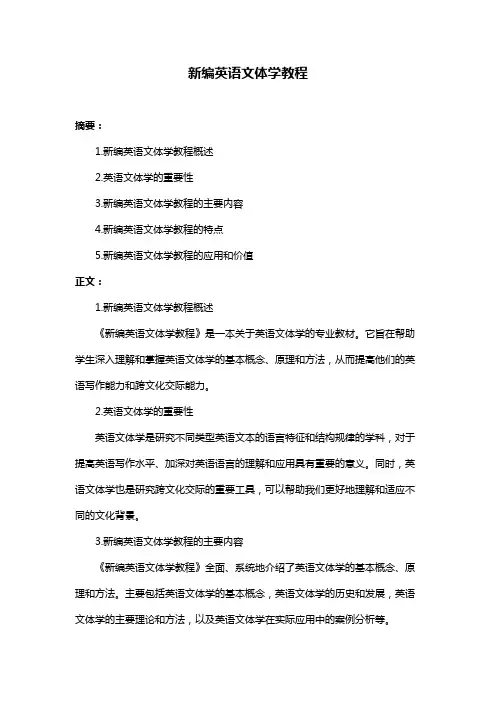
新编英语文体学教程
摘要:
1.新编英语文体学教程概述
2.英语文体学的重要性
3.新编英语文体学教程的主要内容
4.新编英语文体学教程的特点
5.新编英语文体学教程的应用和价值
正文:
1.新编英语文体学教程概述
《新编英语文体学教程》是一本关于英语文体学的专业教材。
它旨在帮助学生深入理解和掌握英语文体学的基本概念、原理和方法,从而提高他们的英语写作能力和跨文化交际能力。
2.英语文体学的重要性
英语文体学是研究不同类型英语文本的语言特征和结构规律的学科,对于提高英语写作水平、加深对英语语言的理解和应用具有重要的意义。
同时,英语文体学也是研究跨文化交际的重要工具,可以帮助我们更好地理解和适应不同的文化背景。
3.新编英语文体学教程的主要内容
《新编英语文体学教程》全面、系统地介绍了英语文体学的基本概念、原理和方法。
主要包括英语文体学的基本概念,英语文体学的历史和发展,英语文体学的主要理论和方法,以及英语文体学在实际应用中的案例分析等。
4.新编英语文体学教程的特点
《新编英语文体学教程》具有以下特点:首先,结构严谨,内容全面,既注重理论知识的讲解,又注重实践应用的分析;其次,采用最新的研究成果和实例,贴近实际,富有时代感;最后,编写风格简洁明了,易于理解和学习。
5.新编英语文体学教程的应用和价值
《新编英语文体学教程》不仅可以作为英语专业教材,也可以作为广大英语学习者的参考书。

英语文体学教程(总9页)--本页仅作为文档封面,使用时请直接删除即可----内页可以根据需求调整合适字体及大小--Chapter11, what is style in your opinion according to what we have studied in this chapter?Anwser1 , from the perspective of the content, the events and activities described ,style is saying different things in different ways ;from the perspective of the ways of expression used ,styled is same thing in different ways; from the perspective of the users of language ,style is different speakers using language in different ways; and from the perspective of the text ,style is the functions of texts for different purposes.Anwser2, the definition of style is the concept of style as choice .this definition can have at least too interpretations .one is that first we have a pre-existing thought ,and then we choice the appropriate type of expression to express it in language. The chosen expression is the style .another is that the choice refers to the choice of meaning. The choice of language is at the same time a choice of meaning and a choice of style .2,what is the significance of studying the style of language in learning and teaching English?Anwser, the answer is that if we want to use language appropriately in different situations , we need to study style .as foreign language learners, if we disregard the rules of using what variety of language in what occasion , or fail to obey them through ignorance , language can become instead a barrier to successful communication . Therefore its necessary to have a clear awareness of how language should be used in different types of situations especially in unfamiliar situations.3, what factors can result in differences in styleAnswer , 1, the different types of vocabulary create different images of the events in the reader’s mind, so they can result in different ,people living in different periods of time in history will also speak differently ,and that will result in a different style.Chapter21, explain the following terms1),foregrounding: the stylistically significant features have to be prominent and motivated ,that is ,foregrounded.2),incongruity: the linguistic features depart from the normal use of language ,breaking the rules grammar ,spelling ,pronunciation.3)deflection : the linguistic features don’t depart from the established grammatical, lexical and logical rules and principles ,but have an unexpected high frequency of occurrence.4),field; its concerned with what is happening ,including the subject matter,the events happenings,going-ons, the content ,etc5)tenor: its concerned with who is taking part in the exchange of meaning ----the relationship between the speaker and the listener ,their relative status,their attitude,and their role relations .6)mode: its concerned with how the interaction is conducted ,that is whether it is written or spoken ,or whether it is expressed by phonic substance or graphic substance.2,question for discussion2)in rhetorical series,the number of items can influence the stylistic to analyze the causes on the basis of social culture.Answer :different numbers of words can produce different stylistic effects in the appropriate contexts. Two items express assertion ,that is ,it is just this ,not that .In appropriate situations three items can produce ethic ,persuasive, and representative effect. Four or more items in a series stress a large number of the concrete things ,and these can produce an imagery in the mind of the reader that the large amount of things constitutes a significant situation in which certain aspect are highlighted. Another function of the rhetorical series is to use concrete items to highlight abstract concepts so that the abstract concept can be expressed in concrete ,lively and vivid way to enhance the aesthetic value of language.3)what factors affect the writer’s selection of words and styleAnswer : five criteria for the selection of words :whether they are familiar or not familiar, whether they are concrete or abstract, whether they are single or more ,whether they are short and simple. Or long. Whether they are Anglo –saxon words or latin words .field ,tenor ,mode affect the writer’s selection of style.4)what is the criterion used to classify wordsAnswer :we can use more systematic way to classify word according to register and dialect .register:field ,tenor , mode .dialect: regional dialect,such as London dialect;social dialect such as dialect of age, race, dialect such as od English .5)through what channels can words be used to achieve transferred meaning?Answer :simile :x is like Y, eg as busy as bee. Metaphor: X is Y ,eg he is a pig.Synecdoche eg many hands represent the people who work with their hands . Metonymy eg purse represent money.Chapter31,explain the following terms1),chiasmus:chiasmus is formed by inverting the word order of the second part of a parallel structure,so it forms a kind of antithetical structure. Eg:let us never negotiate out of fear,but let us never fear to negotiate.2)antistrophe: it is the repetition of the same items but in inverted order ,eg:what’s polly to me,or me to polly3)epizeuxis:it is a continuous repetition for high lighting a particular feature.4)ploce: the repetition is not continuous , but intermittent or dispersed in the text.5)loose sentence: put the major idea first and than the illustration .such a sentence is easy to grasp .6)periodic sentence:a periodic sentence can be used to create suspense,or expectation, thus drawing the listener’s attention to the end of the can be used to produce humorous and emphatic effect .2,question for discussion1),there are many types of syntactic deflection ,but they have one thing in common :recurrence of structures. How is syntactic deflection classified?Answer :there are two type of syntactic deflection :the unexpected high frequency of occurrence of a certain type of sentence; and the overregular occurrence of a particular pattern .2)the high frequency of occurrence of long and short sentence can create stylistic effect .apart from the difference in expressive meanings ,what are other characteristics of the two types of sentences?Answer : long sentences are good to provide the detailed descriptions ,and are good to reveal the mental activities of the speaker .so they are used to produce a vivid, rich, exuberant, luxurious style. Short sentence:can produce direct ,terse ,concise ,clear effect or continuous ,compact ,swift effect ,so that it creates certain atmosphere , and leave a deep impression on the listeners.3) why do writers often violate the rule of grammarWhat do we cal this violation?Answer: we call this violation syntactic incongruity .the violation of the grammatical rules can be used to produce certain stylistic effects. The so-called ungrammatical sentences are used to represent the different varieties oflanguage according to register and dialect. In literary works, dialectical and personal features of speech are often used to depict the personality of the characters. In poetry, the poet often uses deviant grammatical structures to achieve special effects, makes lines terse and concise, to make it rich in meaning.4)what is the function of rhetorical questions?Answer: A rhetorical question is to use the form of a question in order to express a strong emotion or to emphasize a particular aspect. The function of inverted sentence is to make a declarative sentence more powerful, to attract the listener’s attention, or to induce others’ sympathy. Arranged in parallelism, rhetorical questions can express strong emotions and increase the persuasive power. A rhetorical question can also introduce the topic of the text.5) In what ways can we use inverted sentences to achieve emphatic effect? Answer: to change the normal word order can be used to produce some emphatic effect. What is put to the initial part of the sentence is usually the focus of information of the clause and also the theme of he clause. So it is highlighted. Chapter41 explain the following terms1)Synaesthesia: it refers to the fact that sounds s are attributed withcertain values or esthetic features. It is very casual, and supported by situational features and meaning.2)Alliteration: refers to the repetition of the initial sound usually aconsonant, or a vowel at first position, in two or more words that occur close together.3)Assonance: refers to the use of the same or related vowel sounds insuccessive words. It can create harmonious effect.4)Consonance: refers to the repetition of the last consonants of the stresseswords at the end of the lines.2 questions for discussion1)What are the characteristic of spoken language and written languagerespectively?2)3)Answer: spoken language: 1 it can directly be accompanied by other non-linguistic means as the aid; 2 it is generally speaking not as formal as written language; 3 it permits errors in the process of production; 4 it uses a particular grammar, a grammar characteristics of spoken language. 5 homophonescan be used for special stylistic effects, such as pun; 6 some implications are best represented by special sound features; 7 sound feature can represent the feature of regional dialect or social dialect.Written language:1 as written language communication is usually not a direct one, but is delayed in time and at different places, the writer generally has time to get well prepared and revise the text before he sends it out to the reader;2 as space is limited, it has special grammatical features so as to put more meaning in it .there are many nominalizations to make sentences into groups;3 written language is often used in a more formal situation; 4 as time is enough, it is usually written in a more detailed and logical way;5 as written language is more purposeful, and for a single specific goal, it is usually more constant and developed around a single subject.4)How many sound patterns do we have What special stylistic effects can beachieved by themAnswer: these sound patterns include alliteration which can create harmony, connection and achieve special stylistic effects, assonance which can create harmonious effect, and consonance5)What factors can influence graphological prominence .Answer: there are three distinctive factors that can produce graphological prominence: marking, spacing and sequence. Marking refers to the use of written symbols to convey information; space is spacing arrangement departing from this normal way of spacing can be used to achieve stylistic effects.4 In modern English, punctuation marks are patterned and standardized. How can we use punctuation marks for special stylistic purpose?Answer: period typically occurs at the end of a declarative sentence. If period occurs in unexpected high frequency of occurrence, it often means that the text mainly functions to provide information; comma is used to mark the unit larger than a word, however, in Charles Dickens’ Dombey and Son, comma is used to indicate syllables; exclamation marks can be used to carry emotional coloring, a mark of expressing special feelings; parentheses are used for further explanation; the ellipsis of punctuation marks produces an illogical and non-sequential image.Chapter71 explain the following terms1)Guide: guide is the further explanation of the headline, it consists of six elements; location, character, event, mode, time, and cause.2)Nominalization: refers to a grammatical phenomenon in which the meaning which is normally expressed by a clause is here expressed by a phrase, so clause nominalization is normal. It is contracted.3)The highlighting method: from the productive point of view, the columnist can publish the whole story, or he can cut off some parts from the end. He can even cut off the main body.4)Meaning contraction: using the smallest form to get the most meaning.5)Journalese words: as new report requires the speaker to use the least form to get the most meaning, and it has to be fresh and attractive, so the words in news report is short and new.2 questions for discussion1) What are semantic features of news report?Answer:1 In terms of ideational meaning, apart from the semantic field of news report, it covers virtually all areas of meaning systems ;2 in terms of interpersonal meaning, it stresses objectivity;3 in terms of textual meaning, it has the feature of meaning contraction.3) Most of the headlines are elliptical sentences. Tell in what way ellipsis is best achieve in news report.Answer: most of the headlines are elliptical sentences. What is omitted is: (a) subject-predicate (b) predicate (c) link verb or auxiliary verb4) How is meaning contraction of news report embodied in grammar?Answer: one feature of news report is meaning contraction, that is using the smallest form to get the most meaning .its grammatical feature are as follows:(1) the nominalization of the processes (2)big noun phrases and complex modifications (3)as some of the pre-modifiers come from a separate clause, it is highly contracted .5)The concreteness contraction of news report is in contradiction to meaning contraction. Tell how this contradiction is revolved in news report.Answer: besides its authenticity and objectivity, news report should also emphasize concreteness and detailedness. Therefore, the writer often gives background information and details by using parenthesis. By doing so, the writer can provide concrete and detailed information and save space as well.6)What graphological means are used in news report Analyze what effects are achieved by graphological means.Answer: grphological means are made in the typesetting, for example, headlines can be arranged in such ways: 1 flush-left(it is made into a square) 2dropped-line(the length of the line is the same, but dropped in a bit each time) 3 short line followed by a long tome 4 along line followed by a short line 5 concave form 6 convex form . They can increase esthetic value and become more attractive.7)What are lexical features of news report Why are many nonce words used in news reportAnswer: lexical feature: 1 short and new-fashioned such a “crisis” in “the UN faces crisis of credibility”. 2 short journalese phrase such as “key issue” in “jobless will be the key issue in 1993”. 3nonce w ords, often blends such as Euromarket=European market.8)Why is there so much use of direct speech in news report?Answer: the use of direct speech can enhance the credibility of news report. The directly quoted speech can be regarded as basis of facts.9)What prominent devices are used in headlines in news report?Answer: alliteration allusion suspense etc.Chapter61Explain the following terms1)time non-fluency :pauses in inappropriate positions within a phrase or groups position ,the use of um or er to delay the time ,the repetition of some expressions ,such as be said be said be said.,2)Quality non-fluency: often the speaker cannot find the appropriate words to express himself, and he is striving for words, so he uses many inexact expressions and even wrong expressions or wrong pronunciations to express himself.3)Adjacency pair: most of the sentences are declarative and interrogative sentences as they are mostly made up of questions and answers.4) Slot filling words: slot filling words are used to fill in the pauses when the speaker strives for meaning as words, or when he or she strives to be politeness or lessen the degree of imprudence.2 question for discussion1)What are the characteristics of conversation from the perspective of semantics, grammar, vocabulary and phonology?Answer :semantic features:(1)the inexplicitness of meaning (2)the randomness of subject matter, and a general lack of planning (3)the lack of fluency Grammatical features :(1)sentence complexity (2)verbal phrases(3)nominal phrases(4)the types of sentences (5)quoted elements. Lexical feature:(1)mostof the words are short and simple Anglo-Saxon ones, (2)the choice of words is limited in scope or range (3)slang and colloquial words, taboo words ,exclamatory words are frequently used (4)some slot filling words ,suchas you know ,I mean,etc.(5)use exaggerated words and expressions. Phonological features :(1)use more contractions for the unimportant information (2)the often try to express themselves in spite of the fact that the other is speaking (3)there are many emphatic ways of speech ,such as stress .2)How do you account for the inexplicitness of language in daily conversation?Answer: the inexplicitness of meanings manifested in the following aspects: (1)lots of exophoric expression such as “this “is the tendency (2)there are missing links between the utterances(3) a lot of background information missing.(4)many inexact expressions using general words for particular concepts(5)many incomplete expressions.3)What are the features spontaneous commentary from the perspective of semantics, grammar, vocabulary and phonology?Answer: from the perspective of semantic features, if the listeners could also see the event while the commentary is delivered, there will be a lot of meaning implied or simply presupposed; but in a commentary without visual support on the part of the listeners, the commentator has to provide all the necessary information. In terms of syntactic structure, the sentences and the clauses are usually short as the commentator has no time to give detailed descriptionof the event, and the sentences contain fewer words than usual. From the perspective of lexical features, the words are mostly simple in structure, they are short and simple; they are mostly composed of verbs, and proper names; there might be specialized terms depending on the subject matter of the commentary. From the perspective of phonological features, it is very fast and fluent, but he has to pronounce every word clearly and loudly.4)What are the features of text structure of public speech?Answer: It consist of the following element :(1)a short introduction to the main issue or issues concerned (2)the declaration of one’s attitude and position in the matter (3)the listing, reasoning, and explaining (4)conclusion 5)How is it that in public speech there is much use of noun phrases with post modification?Answer: there are few pre-modifiers, but more post-modifiers such as “of phrase” and “which clauses” to giv e detailed and accurate description. Chapter81 explain the following termsLearned words: learned words are words that borrowed from Latin, Greek and French.Clichés:are words or expressions which have lost their originality or effectiveness because they have been used too often.Semantic features: correctness and completeness; conciseness and clearness; consideration and courtesy. Grammatical features: sentences structure; uses of voices; uses of affirmative sentences; inverted sentencesLexical features: concrete and natural words; technical terms and abbreviations; brief and common word s; avoid clichés (except business contracts)3 questions for discussion1)Why should business English be correct and complete?Answer: the content of business English should be correct and completely. First, the conveyed information should be correct; sometimes a small mistake would cause a great loss in a deal and even affect business relations between two parties. Second, the conveyed information should be complete. For example, if we order some commodities, we should state names of commodities, delivery dates, consignees, methods of payment, etc.2)In business English sometimes active voice is used, and sometimes passive voice is preferred. Point out what stylistic features can be achieved through using voices. Answer: In business English, both active voice and passive voice can be used, but there is a tendency towardspreference of active voice in today’s business communication. Active voice is shorter in form and economic in words compared with passive voice. Thus active voice is more effective in stylistic effect than passive voice; besides, active voice can make style more familiar and less formal. But in some cases, passive voice is necessary. When we discuss something negative, we should avoid blaming the other party directly, in addition, passive voice can make business English style more formal, and the conveyed information more objective.3)Why should business letters be written in a way of consideration and courtesy?Answer: In business communication, in order to make it more efficient, we should be considerate of others and polite to others. “You- Attitude” is very important principle in business communication, that is, we should think ourselves back into the shoes of others so as to cooperate sincerely.4)The use of technical terms and abbreviations is one stylistic feature of business English. State the reason of this phenomenon.Answer: using technical terms and abbreviations can avoid long and tedious explanation, which is one lexical feature of business English. Such as L/C----letter of credit5)Why should we avoid clichés in business English?Answer: clichés are words or expressions which have lost their originality or effectiveness because they have been used too often. In old-fashioned business English there are a large number of clichés, which should be avoid in present-day business communication.Chapter91, explain the following terms2) Redundancy: in order to avoid opaqueness and ambiguity, it has express clearly what everyone knows and takes for granted. This makes the legal language redundant clumsy and hard to understand.3) Common words: many of the legal words come from ordinary language with the common core features especially those high-frequency words, such as prepositions, conjunctions, articles, etc.4) specialized words: specialized words are necessary for two important aspects of legal language. The first is that for the field of law itself, and the second is that for many non-legal field concerned with legal affairs. There are two sources of specialized legal words: common words endowed with legal meanings and archaic words.2, question for discussion1)Why is legal English syntactically complex?2)3)Answer: syntactic Complexity: as its main function is to ensure preciseness and accuracy and block any leakage, the draftsmen of legal documents have to be very carful and scrupulous, and the legal texts have to be able to stand the text of time .therefore legal language is rich in modifications, circumlocutions, and complex logic relations.2)Legal English is very conservative in form. Explain it from a historical perspective.Answer: conservativeness: as the legal language is produced by careful phrasing and tested over a long time, nobody dares to alter the structure of legal English, so that its structures become old-fashioned and archaic. The representative legal language in such a way is English legal language.3) What is the reason that there are many legal words of French source?Answer: because after the Norman Conquest, French because the official language used for all state affairs including law in Great Britain. That is why many French loan words were found in law afterwards.4) What are the lexical features of legal English?Answer: legal vocabulary mainly comes from French. (2) Legal words can be divided into following three types: 1, common words2, specialized words3, Multi-register words.。
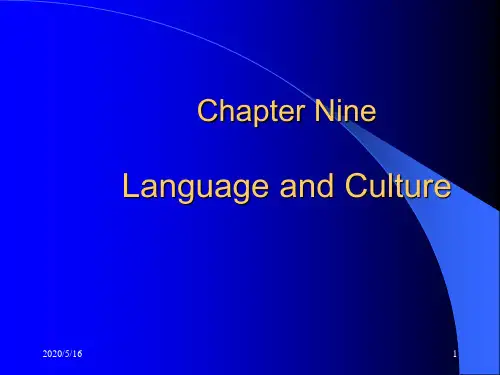
新编英语文体学教程摘要:一、引言1.英语文体学的概念与重要性2.新编英语文体学教程的目的和适用对象二、英语文体学的基本原理1.语言的定义与功能2.语言的结构与系统3.语言的变化与演化三、文体学的主要研究内容1.文体与风格2.语体与语境3.文体分析的方法与技巧四、英语文体学的实际应用1.写作与翻译2.口语与听力3.阅读与教学五、英语文体学教程的学习建议1.注重基础知识的掌握2.加强实践训练3.培养跨文化交际能力正文:在新编英语文体学教程中,我们首先探讨了英语文体学的概念以及它在我们日常英语学习和应用中的重要性。
英语文体学作为语言学的一个重要分支,关注的是英语在不同语境下的运用与表达,以及英语语言在使用过程中的变化与发展。
教程的第一部分重点介绍了英语文体学的基本原理。
在这一部分,我们首先明确了语言的定义,即人类为了表达思想和进行沟通而采用的一种符号系统。
随后,教程详细讲解了语言的结构与系统,包括语音、词汇、语法等组成部分,以及它们之间的关系和作用。
最后,教程简要介绍了语言的变化与演化,包括语言的起源、发展、地域差异和时代变迁等方面。
在教程的第二部分,我们深入探讨了文体学的主要研究内容。
首先,教程详细解释了文体与风格的区别与联系,以及如何通过文体和风格来表达意义和传递信息。
接着,教程介绍了语体与语境的概念,强调了在实际交际中,要根据不同的语境选择合适的语体。
最后,教程讲解了文体分析的方法与技巧,包括如何运用这些方法和技巧来分析英语文本,以揭示其深层次的意义和结构。
在教程的第三部分,我们着重讨论了英语文体学的实际应用。
首先,教程介绍了写作与翻译中如何运用文体学的知识和技巧,以提高写作和翻译的质量。
其次,教程讲解了口语与听力中如何运用文体学的原理,以提高口语表达和听力的水平。
最后,教程从阅读和教学的角度,阐述了如何运用英语文体学的知识来提高英语阅读能力和教学效果。
在教程的最后部分,我们提出了英语文体学教程的学习建议。
Unit 9 SnakeLine 1trough[ˈtrɔ:f]: a long, narrow open container for animals to eat or drink out of(给动物进食或饮水的)槽a water trough水槽Line 2pyjama [pəˈdʒɑ:mə] ---pyjamas [pəˈdʒɑ:məz] [pl. ]: n. a suit of loose trousers and jacket for sleeping in睡衣裤a pair of pyjamas一套睡衣裤 pyjama trousers睡裤Line 4Scent [sent]: n. 1)a distinctive smell, especially one that is pleasant气味;香味2) [mass noun]pleasant-smelling liquid worn on the skin; perfume. 香水v. (一般作 be scented with)impart a pleasant scent to使有香味scented [ˈsentid]: adj. 有香味的; 芳香的, 洒了香水的, 加有香料的eg: I let my lungs fill with the scented air. 我呼吸着芬芳的空气。
She rubbed a scented oil into her hair. 她在头发上抹了一种芳香油。
Shade: n. comparative darkness and coolness caused by shelter from direct sunlight荫;阴凉处Carob [ˈk ærəb]: (亦作 carob tree)a small evergreen Arabian tree which bears long brownish-purple edible pods 角豆树; 长豆角Line 5Pitcher [ˈpɪtʃə]: n. a large earthenware container, with one or two handles and a lip, for holding liquids (英)(有柄和嘴的)水罐Eg: He poured the milk out of the pitcher. 他从大罐中倒出牛奶。